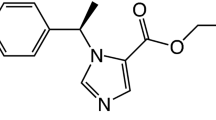Abstract
Agmatine was isolated from bovine brain in 1994. It exhibits various functions, as a consequence of which it meets the criteria for an endogenous brain neurotransmitter. However, its physiological action on the cardiovascular system remains unclear. This study was designed to clarify its cardiovascular effects when administered into the rostral ventrolateral medulla (RVLM) in anesthetized and paralyzed rats. Unilateral injection of clonidine (5 nmol) into the RVLM significantly decreased mean arterial pressure (MAP) and heart rate (HR). Unilateral injection of agmatine (5 nmol) produced similar effects to clonidine. The amplitude of the decrease in HR was the same as with clonidine, but the amplitude of the decrease in MAP was less pronounced. The cardiovascular inhibition induced by clonidine (5 nmol) and agmatine was abolished by idazoxan (5 nmol). Similar to clonidine, agmatine inhibited the pressor effect of l-glutamate (2 nmol) injected into the RVLM. The duration of this effect (about 6 min) was shorter than that observed with clonidine (about 12 min). Bilateral injection of agmatine into the RVLM inhibited the depressor response induced by baroreflex activation (electrical stimulation of the aortic nerve), and this effect was similar to, but less pronounced than, that induced by clonidine. Idazoxan (5 nmol) antagonized the cardiovascular effects of clonidine and agmatine within the RVLM. However, it produced a similar effect to clonidine injected into the RVLM. It is concluded that agmatine exerts a similar cardiovascular effect to clonidine, with less potency within the RVLM. Idazoxan might be a partial agonist for imidazoline I1 receptors.






Similar content being viewed by others
References
Bruban V, Feldman J, Greney H, Dontenwill M, Schann S, Jarry C, Payard M, Boutin J, Scalbert E, Pfeiffer B, Renard P, Vanhoutte P, Bousquet P (2001) Respective contributions of α-adrenergic and non-adrenergic mechanisms in the hypotensive effect of imidazoline-like drugs. Br J Pharmacol 133:261–266
Dampney RAL (1994a) Functional organization of central pathways regulating the cardiovascular system. Physiol Rev 74:323–64
Dampney RAL (1994b) The subretrofacial vasomotor nucleus: anatomical chemical and pharmacological properties and role in cardiovascular regulation. Pro Neurobiol 42:197–227
Drolet G, Aslanian V, Minsion J, Morris M, Chalmers J (1990) Differences in the central hypotensive actions of alpha-methyldopa and clonidine in the spontaneously hypertensive rat: contribution of neurons arising from the B3 and the C1 areas of the rostral ventrolateral medulla. J Cardiovasc Pharmacol 15:118–123
Feng Y, Halaris AE, Piletz JE (1997) Determination of agmatine in brain and plasma using high-performance liquid chromatography with fluorescence detection. J Chromatogr 691:277–286
Goodchild AK, Dampney RAL, Bandler R (1982) A method for evoking physiological responses by stimulation of cell bodies, but not axons of passage, within localized regions of the central nervous system. J Neurosci Method 6:351–363
Guyenet PG (1990) Role of the ventral medulla oblongata in BP regulation. In: Loewy AD, Spyer KM (eds) Central regulation of autonomic functions. Oxford University Press, New York, pp 145–167
Guyenet PG (1997) Is the hypotensive effect of clonidine and related drugs due to imidazoline binding sites? Am J Physiol 273: R1580–R1584
Head GA, Chan CK, Godwin SJ (1997) Central cardiovascular actions of agmatine, a putative clonidine-displacing substance, in conscious rabbits. Neurochem Int 30:37–45
Li G, Regunathan S, Barrow CJ, Eshraghi J, Cooper R, Reis DJ (1994) Agmatine: an endogenous clonidine-displacing substance in the brain. Science 263: 966–969
Li G, Regunathan S, Reis DJ (1995) Agmatine is synthesized by mitochondrial argentine decarboxylase in rat brain. Ann N Y Acad Sci 763:325–329
Otake K, Ruggiero DA, Regunathan S, Wang H, Milner TA, Reis DJ (1998) Regional localization of agmatine in rat brain: an immunocytochemical study. Brain Res 787:1–14
Paxinos G, Watson C (1986) The rat brain in stereotaxic coordinates, 2nd edn. Academic Press, New York
Raasch W, Regunathan S, Li G, Reis DJ (1995) Agmatine, the bacterial amine, is widely distributed in mammalian tissues. Life Sci 56:2319–2330
Raasch W, Schafer U, Qadri F, Dominiak P (2002) Agmatine, an endogenous ligand at imidazoline binding sites, does not antagonize the clonidine-mediated blood pressure reaction. Br J Pharmacol 135:663–672
Reis DJ (1996) Neurons and receptors in the rostroventrolateral medulla mediating the antihypertensive actions of drugs acting at imidazoline receptors. J Cardiovasc Pharmacol 27: S11–S18
Reis DJ, Regunathan S (2000) Is agmatine a novel neurotransmitter in brain? Trends Pharmacol Sci 21:187–193
Reis DJ, Yang XC, Milner TA (1998) Agmatine containing axon terminals in rat hippocampus form synapses on pyramidal cells. Neurosci Lett 250:185–188
Sastre M, Regunathan S, Galea E, Reis DJ (1996) Agmatinase activity in rat brain: a metabolic pathway for the degradation of agmatine. J Neurochem 67:1761–1765
Sastre M, Regunathan S, Reis DJ (1997) Agmatine is transported by a specific uptake system into rat brain synaptosomes. J Neurochem 69:2421–2416
Schreihofer AM, Guyenet PG (2000) Role of presympathetic C1 neurons in the sympatholytic and hypotensive effects of clonidine in rats. Am J Physiol 279: R1753–R1762
Su DF, Yang YC, Xie JE (1992) Effects of ketanserin on blood pressure and heart rate in sinoaortic denervated rats. Eur J Pharmacol 214: 89–91
Wang WZ, Yuan WJ, Su DF (2003a) Blockade of N-methyl-d-aspartate receptors within the rostral ventrolateral medulla antagonizes clonidine-induced cardiovascular effects. Auton Neurosci 109:21–28
Wang WZ, Yuan WJ, Yang J, Wang JW, Tang CS, Su DF (2003b) Involvement of I1-imidazoline receptors in baroreceptor reflex in the caudal ventrolateral medulla of rats. Brain Res 960:16–24
Yang XC, Reis DJ (1999) Agmatine selectively blocks the NMDA subclass of l-glutamate receptor channels in cultured mouse hippocampal neurons. J Pharmacol Exp Ther 288: 544–549
Acknowledgments
This work was supported by the National Natural Science Foundation of China (30170385, 30330650) and the Shanghai Foundation for Science and Technology Development (No. 014909004).
Author information
Authors and Affiliations
Corresponding author
Rights and permissions
About this article
Cite this article
Yang, J., Wang, WZ., Shen, FM. et al. Cardiovascular effects of agmatine within the rostral ventrolateral medulla are similar to those of clonidine in anesthetized rats. Exp Brain Res 160, 467–472 (2005). https://doi.org/10.1007/s00221-004-2034-7
Received:
Accepted:
Published:
Issue Date:
DOI: https://doi.org/10.1007/s00221-004-2034-7




